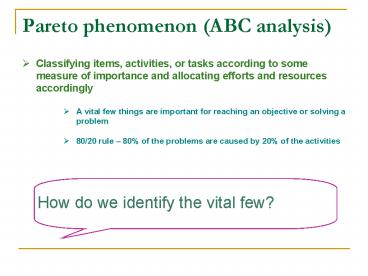Pareto phenomenon (ABC analysis) - PowerPoint PPT Presentation
1 / 10
Title:
Pareto phenomenon (ABC analysis)
Description:
long term forecasting, product design, capacity planning, inventory management. ... forecasting, production planning, quality assurance, inventory management ... – PowerPoint PPT presentation
Number of Views:968
Avg rating:3.0/5.0
Title: Pareto phenomenon (ABC analysis)
1
Pareto phenomenon (ABC analysis)
- Classifying items, activities, or tasks according
to some measure of importance and allocating
efforts and resources accordingly - A vital few things are important for reaching an
objective or solving a problem - 80/20 rule 80 of the problems are caused by
20 of the activities
How do we identify the vital few?
2
Pareto phenomenon, ABC analysis, Recognition of
Priorities
- Acknowledging the fact that certain aspects of
any management situation are more important than
others is called Recognition of Priorities.
3
Models
- A model is an abstraction of reality
- Physical
- Schematic
- Mathematical
4
Quantitative approach
- Linear programming
- Transportation model
- Inventory models
- Waiting line models
- Statistical models
5
Recent Trends
- Global Competition
- Operations Strategy
- Flexibility
- Cycle Time Reduction
- Business Process Re-engineering
- Supply Chain Management
- Workers Involvement
- Lean Manufacturing
- Total Quality Management
6
Recent Trends
- Global Competition
- Global Market
- Global Suppliers
- Operations Strategy
- Quality based
- Time based
- Flexibility
- Variety of products
- High Volume as well as Low Volume
- Cycle Time Reduction
- The less time RM (Raw Material), WIP (Work In
Process), FG (Finished Goods) spend in the
Manufacturing and Logistics process, the less
opportunity they have to absorb costs.
7
Recent Trends
- Business Process Re-engineering
- Value added and NVA activities
- Supply Chain Management
- NOT from RM storage to FG warehouse
- From the original suppliers to final consumers
- Workers Involvement
- Workers are not costs, they are assets
- Lean Manufacturing
- Inventory is waste
- Total Quality Management
8
Examples of Exam Questions
- 1. The following activities are all a part of
system operations as opposed to system design - long term forecasting, product design, capacity
planning, inventory management. - short term forecasting, product design, capacity
planning, inventory management - short term forecasting, production planning,
capacity planning, inventory management - short term forecasting, production planning,
quality assurance, inventory management - none of the above
- 2. Pareto Phenomenon is the same as
- ABC analysis
- analysis of trade-off
- systems analysis
- quantitative approaches
- none of the above
9
Review Questions (cont.)
- 3. In ABC analysis
- 25 of items form 25 of the measure of
importance - 10 of items form 10 of the measure of
importance - 90 of items form 90 of the measure of
importance - 50 of items form 50 of the measure of
importance - 15 of items form 75 of the measure of
importance
- 4. Given
- (I) Lean operations, (II) Operations strategy,
(III) Business process re-engineering - (A) Inventory is waste, (B) Time based
operations, (C) High Volume as well as Low
Volume, - (D) Value-added and NVA activities
- Which of the following selections is correct?
- (I) matches with (D), (II) matches with (C),
(III) matches with (B) - (I) matches with (A), (II) matches with (B),
(III) matches with (C) - (I) matches with (A), (II) matches with (B),
(III) matches with (D) - (I) matches with (A), (II) matches with (D),
(III) matches with (C) - (I) matches with (C), (II) matches with (D),
(III) matches with (B)
10
Review Questions (cont.)
- 5. Given
- (I) supply chain management, (II) Flexibility,
(III) Operations strategy - (A) Quality based operations, (B) Workers are
asset, (C) Value added and NVA activities, - (D) from suppliers to consumers, (E) High Volume
as well as low volume - Which of the following selections is correct?
- (I) matches with (D), (II) matches with (E),
(III) matches with (C) - (I) matches with (D), (II) matches with (E),
(III) matches with (A) - (I) matches with (A), (II) matches with (E),
(III) matches with (D) - (I) matches with (C), (II) matches with (D),
(III) matches with (E) - (I) matches with (E), (II) matches with (B),
(III) matches with (D)































